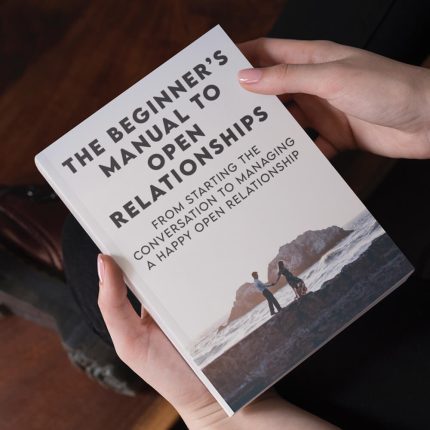Fluid Bonding

Imagine a love so seamless and flowing that the barriers between you and your partner melt away like ice on a sunny day. Welcome to Fluid Bonding—a concept in ethical non monogamy where emotional, physical, and even symbolic barriers dissolve to create an intimate connection that is as dynamic and adaptable as water itself. Picture a relationship where trust and vulnerability mix freely, forming bonds that are deep, flexible, and ever-evolving. If you’re ready to explore how fluid bonding can transform your connections into a living, breathing partnership that flows effortlessly through life’s twists and turns, read on!
Have you ever wondered if monogamy is just a stupid little experiment? Open relationships, polyamory, relationship anarchy...find out which relationship dynamic suits you best with our one minute relationship test. See if you are just conforming to "societal norms". Reveal your truth >>
Quick Links to Useful Sections
- The Ethical Non Monogamy Term: Fluid Bonding
- What Is Fluid Bonding?
- Core Principles of Fluid Bonding
- Historical and Cultural Perspectives on Fluid Bonding
- From Rituals to Modern Intimacy
- Cultural Shifts in Modern Relationships
- Everyday Dynamics of Fluid Bonding
- Practical Steps to Achieve Fluid Bonding
- Everyday Practices and Rituals
- Benefits of Embracing Fluid Bonding
- Deepened Trust and Intimacy
- Empowerment and Shared Growth
- Flexibility and Adaptability
- Enhanced Emotional and Physical Well-Being
- Challenges of Fluid Bonding
- Managing Vulnerability
- Maintaining Clear Communication
- Balancing Safety with Intimacy
- Navigating External Judgments
- Frequently Asked Questions (FAQ)
- Resources and Community Support: Your Next Steps
The Ethical Non Monogamy Term: Fluid Bonding
What Is Fluid Bonding?
Fluid Bonding refers to the intentional process of removing barriers—both physical and emotional—between partners once a deep level of trust has been established. In the context of ethical non monogamy, it’s not about reckless abandon, but rather about creating a space where intimacy flows naturally and safely. Whether it involves sharing physical fluids as a symbol of total trust or opening up emotionally in a way that feels as natural as breathing, Fluid Bonding is about embracing closeness in a manner that is both liberating and respectful.
At its core, Fluid Bonding signifies a transition from caution to connection. It’s a mutual decision to let go of protective layers, affirming that your relationship has reached a point where both partners feel secure enough to engage in a more profound level of intimacy. This doesn’t mean abandoning all safety or boundaries; rather, it’s about evolving together and adapting your practices to reflect your deepened trust.
Core Principles of Fluid Bonding
- Mutual Trust: Fluid Bonding is built on a foundation of unwavering trust, where every partner feels confident in the safety and commitment of the relationship.
- Intentional Vulnerability: It involves a deliberate choice to be vulnerable—sharing physical, emotional, and symbolic expressions of intimacy.
- Clear Communication: Before any barriers are removed, all parties engage in open, honest discussions to establish expectations and guidelines.
- Informed Consent: Every step of the fluid bonding process is undertaken with full, enthusiastic consent from all partners involved.
- Adaptive Safety: Even as protective barriers are lifted, partners continue to discuss and adapt their safety practices to ensure ongoing well-being.
- Emotional and Physical Alignment: Fluid Bonding is about aligning both emotional and physical connections, reinforcing that the deep trust extends into all facets of intimacy.
Historical and Cultural Perspectives on Fluid Bonding
From Rituals to Modern Intimacy
Throughout history, many cultures have practiced rituals that symbolize unity and the merging of identities. In ancient ceremonies, sharing food, drinks, or other substances was a way to signify a bond between individuals or groups. These traditions laid the groundwork for modern interpretations of fluid bonding in relationships, where physical and emotional intimacy are celebrated as interconnected expressions of trust.
EXPLORE OUR ETHICAL NON-MONOGAMY & OPEN RELATIONSHIP SHOP
👨💻👩💻 Digital Store (Instant Download)
🍆💦 Clothing Store (Worldwide Delivery Available)
Multiple Lovers - Sharing Is Caring Unisex T-Shirt (Black)
$29.99Three Isn't a Crowd Unisex T-Shirt (White)
$29.99Sharing Is Caring Unisex T-Shirt (Black)
$29.99I Love Watching Pop Art T-Shirt (White)
$29.99Three Isn't a Crowd Unisex T-Shirt (Black)
$29.99It's Not Cheating If He Watches T-Shirt (Black)
$29.99Sharing Is Caring Daddy Cap (Black)
$39.99Fuck Each Other Not The Planet Unisex T-Shirt (Black)
$29.99I Love Watching Pop Art T-Shirt (Black)
$29.99Real Men Share Pop Art T-Shirt (White)
$29.99Fuck Each Other Not The Planet Unisex T-Shirt (White)
$29.99Real Men Share Pop Art T-Shirt (Black)
$29.99With the advent of the sexual revolution and the rise of alternative relationship models, the concept of Fluid Bonding evolved. It became a way for couples to express their deep trust and commitment beyond the conventional markers of romance. As ethical non monogamy gained traction, many began to see fluid bonding as a powerful symbol of the evolution of intimacy—one that goes beyond mere physicality to encompass shared vulnerability and mutual growth.
Cultural Shifts in Modern Relationships
Today, especially among Millennials and Gen-Z, there is a growing interest in relationships that defy traditional molds. The idea of Fluid Bonding resonates with those who reject the notion of rigid boundaries and embrace the fluidity of human connection. Social media, digital communication, and online communities have all contributed to a broader understanding of how trust and intimacy can evolve.
In this cultural landscape, Fluid Bonding is celebrated as an empowering step—a conscious decision to break down barriers and experience intimacy in its most authentic form. It’s part of a larger shift toward viewing relationships as dynamic and ever-changing, where the removal of barriers is seen as a natural progression in deepening love.
Everyday Dynamics of Fluid Bonding
Practical Steps to Achieve Fluid Bonding
In everyday life, Fluid Bonding is less about a sudden leap and more about a gradual, intentional process. Here’s how many couples approach it:
- Setting the Stage: Begin with clear, honest conversations about your current emotional and physical boundaries. Discuss what each of you envisions for the next step of intimacy.
- Agreeing on Guidelines: Create a mutual agreement that outlines what aspects of your barriers you’re comfortable removing—whether it’s ceasing the use of physical barriers like condoms (with appropriate safety measures) or sharing more personal, emotional details.
- Taking Incremental Steps: Fluid Bonding often happens in stages. You might start with symbolic gestures—such as sharing a drink or a meal—that represent your willingness to merge emotionally and physically. Over time, you can gradually progress to deeper acts of intimacy.
- Regular Check-Ins: As you begin the fluid bonding process, it’s essential to have regular check-ins. These conversations help you assess how each partner is feeling and adjust boundaries as needed.
- Maintaining Adaptive Safety: Even as you remove certain barriers, continue to engage in discussions about safety. Adapt your practices to ensure that your evolving intimacy remains consensual and secure.
Everyday Practices and Rituals
For many couples, Fluid Bonding is not just a one-time event but a set of ongoing practices that reinforce their deepening connection. Some everyday rituals include:
- Morning and Evening Rituals: Start and end your day by sharing your thoughts and feelings, creating a routine that reinforces your emotional closeness.
- Shared Creative Projects: Engage in activities that require cooperation and mutual input, symbolizing the blending of your individual energies.
- Regular Physical Touch: Incorporate non-sexual physical touch—like hugs, cuddles, or simply holding hands—as a continuous reminder of your bond.
- Symbolic Gestures: Create personal symbols of your commitment, such as matching bracelets or shared art, that represent your decision to become more fluidly connected.
Benefits of Embracing Fluid Bonding
Deepened Trust and Intimacy
One of the primary benefits of Fluid Bonding is the deep trust that develops when partners consciously decide to lower their defenses. This trust, in turn, fosters a level of intimacy that is both profound and resilient.
- Stronger Connection: Removing barriers gradually builds a layered connection that is rich in vulnerability and mutual support.
- Enhanced Communication: The process encourages ongoing dialogue about needs, boundaries, and emotional changes, leading to a more secure bond.
Empowerment and Shared Growth
As you engage in Fluid Bonding, you empower yourself and your partner to grow both individually and collectively. This process of shared vulnerability and open communication transforms intimacy into a catalyst for personal evolution.
- Increased Self-Awareness: Regular check-ins and self-reflection help you understand your evolving needs and desires.
- Collective Empowerment: As each partner grows, the entire relationship benefits from increased resilience and emotional depth.
Flexibility and Adaptability
Fluid Bonding naturally encourages a flexible approach to intimacy. By allowing your emotional and physical boundaries to evolve, you create a relationship that adapts to life’s changes, making it more resilient in the face of challenges.
- Adaptive Boundaries: Continuously renegotiating your limits ensures that your intimacy remains aligned with your current emotional state.
- Resilient Connection: An adaptable relationship can better handle transitions, stress, and unforeseen changes, maintaining its strength over time.
Enhanced Emotional and Physical Well-Being
When you commit to Fluid Bonding, you not only deepen your emotional connection but also enhance your physical well-being. The process of removing barriers is often accompanied by a sense of liberation and improved self-esteem, as you learn to trust and cherish your own vulnerability.
- Increased Intimacy: The blending of emotional and physical bonds leads to a more holistic and satisfying connection.
- Emotional Release: Sharing your true self can be incredibly cathartic, reducing stress and fostering a sense of inner peace.
Challenges of Fluid Bonding
Managing Vulnerability
Opening up emotionally and physically requires a high degree of vulnerability, which can be intimidating if you’ve been hurt before or if you’re naturally guarded.
- Tip: Start slowly by sharing small gestures of vulnerability, and gradually increase as trust builds.
- Tip: Practice self-compassion and remind yourself that vulnerability is a strength, not a weakness.
Maintaining Clear Communication
As you remove barriers, ongoing communication becomes even more critical. Without regular, honest dialogue, misunderstandings can arise, potentially undermining the trust you’re working to build.
- Tip: Schedule regular check-ins to discuss your feelings, update your boundaries, and ensure that everyone is comfortable with the evolving dynamic.
- Tip: Use digital tools to help coordinate and document your conversations and agreements.
Balancing Safety with Intimacy
Fluid Bonding often involves a transition to a more intimate, barrier-free connection, which may include physical expressions of trust such as ceasing the use of certain protective measures. Balancing this increased intimacy with continued safety requires careful consideration and mutual agreement.
- Tip: Discuss and agree upon safety practices beforehand, and be open to revisiting these practices as your relationship evolves.
- Tip: Remember that adaptive safety measures are a part of maintaining both your physical and emotional well-being.
Navigating External Judgments
Not everyone will understand or accept the idea of Fluid Bonding, and external judgments or societal pressures can sometimes create self-doubt.
- Tip: Build a supportive network of like-minded individuals who celebrate your journey toward deeper intimacy.
- Tip: Focus on your internal growth and trust in the strength of your connection rather than external opinions.
Frequently Asked Questions (FAQ)
1. What is Fluid Bonding in ethical non monogamy?
Fluid Bonding is the intentional process of removing emotional, physical, and symbolic barriers between partners once a deep level of trust has been established. It signifies a shift towards a more intimate, unguarded connection.
2. How does Fluid Bonding differ from simply being intimate?
Fluid Bonding goes beyond regular intimacy by representing a deliberate decision to dissolve barriers, both emotional and physical, and create a seamless, evolving connection that adapts with your relationship.
3. What are the core principles of Fluid Bonding?
Core principles include mutual trust, intentional vulnerability, open communication, informed consent, adaptive safety, and a commitment to continuous growth in both emotional and physical intimacy.
4. How can couples begin the Fluid Bonding process?
Start with open discussions about your current boundaries, establish clear guidelines for what aspects of your intimacy you’re ready to evolve, and take incremental steps—symbolic gestures that pave the way for deeper connection.
5. What are some examples of Fluid Bonding rituals?
Examples include sharing a meal without barriers (literal or metaphorical), engaging in prolonged physical affection without protective measures (with mutual consent and safety considerations), or participating in symbolic acts that represent your commitment to vulnerability.
6. How does Fluid Bonding enhance emotional intimacy?
By removing barriers, Fluid Bonding deepens trust and fosters a space where partners can share their true selves, leading to richer, more layered emotional connections.
7. What benefits does Fluid Bonding offer?
Benefits include deeper emotional and physical intimacy, enhanced trust, increased personal growth, and a more resilient, adaptable relationship network.
8. What challenges might arise during Fluid Bonding?
Challenges include managing vulnerability, maintaining ongoing communication, balancing increased intimacy with safety, and navigating any external judgments.
9. How important is communication in the Fluid Bonding process?
Communication is crucial—it ensures that every step of the process is consensual, that boundaries are respected, and that all partners feel secure as the relationship evolves.
10. Can Fluid Bonding be applied to both monogamous and non monogamous relationships?
Yes, while it is often discussed in the context of ethical non monogamy, the principles of Fluid Bonding—trust, vulnerability, and open communication—can enhance any relationship that values deep, evolving intimacy.
11. How do adaptive safety measures work in Fluid Bonding?
Adaptive safety measures involve regularly reviewing and updating your safety practices—such as health checks or protection use—to ensure that as you remove barriers, you continue to protect both your physical and emotional well-being.
12. Where can I find more resources on Fluid Bonding?
Additional resources include books like The Ethical Slut by Dossie Easton & Janet Hardy, podcasts such as Multiamory, and online communities like r/polyamory that explore advanced relationship dynamics.
Resources and Community Support: Your Next Steps
- The Ethical Slut by Dossie Easton & Janet Hardy – A seminal book that delves into the philosophies of ethical non monogamy and provides insights into deepening intimacy through practices like Fluid Bonding.
- Podcasts: Listen to Multiamory and other relationship-focused podcasts for expert advice, personal stories, and practical strategies on navigating Fluid Bonding.
- Online Communities: Engage with forums like r/polyamory to share experiences, seek advice, and connect with others exploring advanced intimacy practices.
- Workshops and Webinars: Attend events on relationship psychology, ethical non monogamy, and intimacy building to deepen your understanding and expand your network.
- Therapy and Counseling: Consider professional guidance if you need help managing vulnerability or navigating the complexities of deep, evolving intimacy.
By exploring these resources and implementing the practical strategies outlined in this guide, you can embark on the transformative journey of Fluid Bonding. Embrace the fluidity of your emotions, celebrate the deepening of your connections, and allow your relationships to evolve into a vibrant, dynamic masterpiece of trust and intimacy.
EXPLORE OUR ETHICAL NON-MONOGAMY & OPEN RELATIONSHIP SHOP
👨💻👩💻 Digital Store (Instant Download)
🍆💦 Clothing Store (Worldwide Delivery Available)
Real Men Share Pop Art T-Shirt (Black)
$29.99Fuck Each Other Not The Planet Unisex T-Shirt (Black)
$29.99Fuck Each Other Not The Planet Unisex T-Shirt (White)
$29.99It's Not Cheating If He Watches T-Shirt (Black)
$29.99I Love Watching Pop Art T-Shirt (Black)
$29.99Three Isn't a Crowd Unisex T-Shirt (Black)
$29.99Sharing Is Caring Daddy Cap (Black)
$39.99Real Men Share Pop Art T-Shirt (White)
$29.99Three Isn't a Crowd Unisex T-Shirt (White)
$29.99Multiple Lovers - Sharing Is Caring Unisex T-Shirt (Black)
$29.99I Love Watching Pop Art T-Shirt (White)
$29.99Sharing Is Caring Unisex T-Shirt (Black)
$29.99Lost & confused by all of the terms, types and seemingly made up 3 letter acronyms?? We've got you. Check out our Ethnical Non-Monogamy Dictionary >>
Useful Interruption: Not sure which relationship vibe fits you best? Take our Relationship Test, it’ll give you the real insight into your natural relationship style. Then, dive into our binge-worthy guides (from the tried-and-true to the “wait, that’s a thing?”) and find the perfect relationship type for your life:
- Monogamy
- Open Relationships
- Ethical Non-Monogamy
- Solo Polyamory
- Non-Hierarchical Polyamory
- Hierarchical Polyamory
- Relationship Anarchy
- Swinging
Now back to the main article but yeah take the test...

































